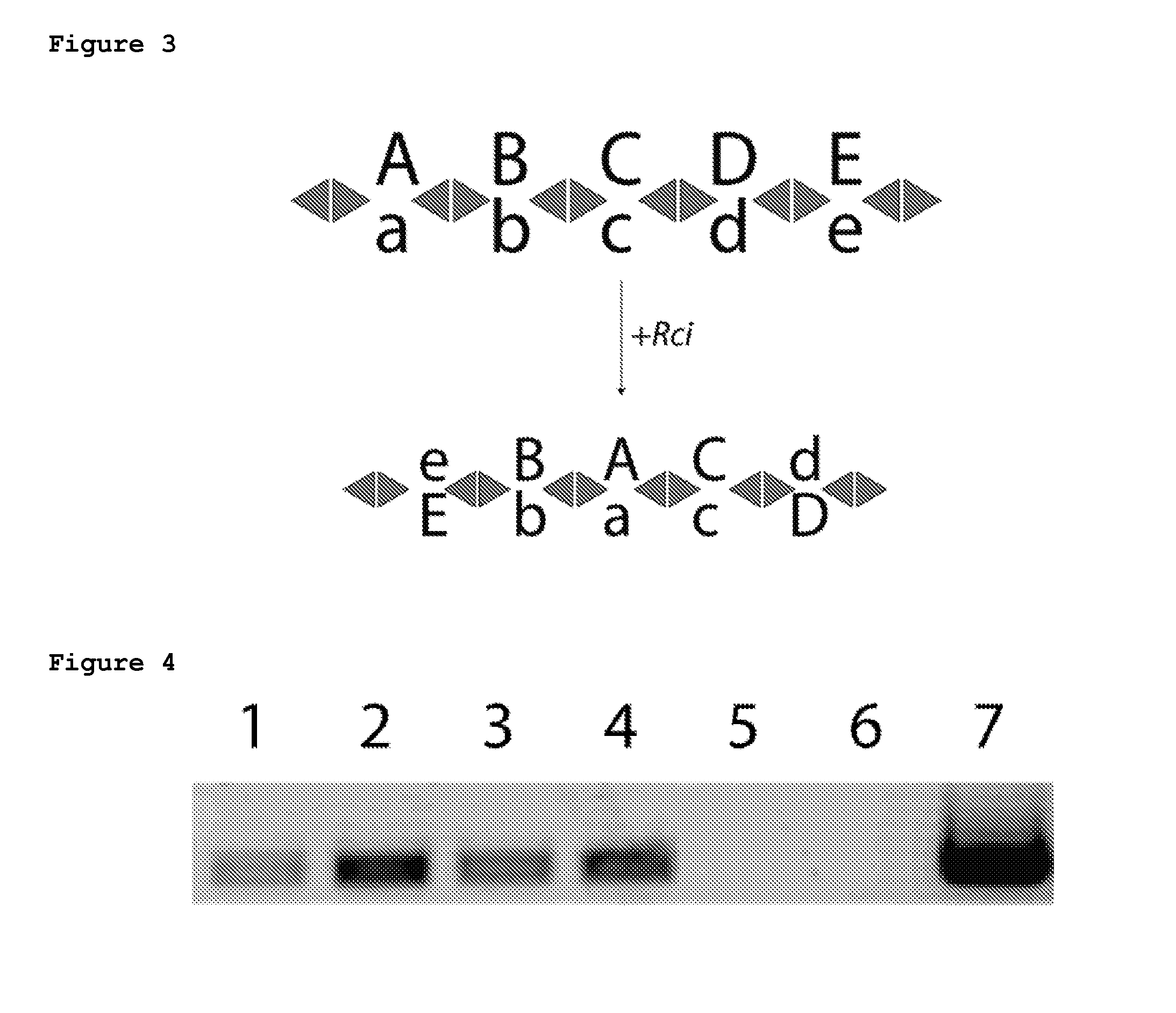Trans-splicing transcriptome profiling
a transcriptome and transsplicing technology, applied in the field of transsplicing transcriptome profiling, can solve the problems of limited methods for probing heterogeneity in cellular expression
- Summary
- Abstract
- Description
- Claims
- Application Information
AI Technical Summary
Benefits of technology
Problems solved by technology
Method used
Image
Examples
example 1
Trans-Splicing Transcriptome Profiling
[0138]First, whether the cellular tagging indeed happens in vivo and not as a result of template switching during RT-PCR was tested. HEK293 cells were separately co-transfected with splicing BC1 and GFP (with an intron) or splicing BC2 and mouse SST (with an intron) and harvested cells 48 hours after transfection.
[0139]The splicing donor consists of the Adeno Virus immediate early intron followed by a 3′ splice site (CAG), although it is expected that any intron will work for this purpose. The sequence of the intron is given below. Immediately following the 3′ splice site is a unique barcode sequence. This barcode sequence can be a static single barcode, or can consist of a high-diversity barcode library generated by a variety of means including but not limited to shotgun cloning of oligonucleotides, in vivo barcode generation by a recombinase, etc. Following the barcode, additional known sequence elements are present to aid in reverse transcrip...
example 2
Genetic Barcode Cassettes
Rci Operation in Bacterial Cells
[0143]A plasmid containing the Rci gene under an inducible T7 promoter and a barcode cassette consisting of 5 fragments was transformed into BL21-DE3 (NEB). Cells were grown in Overnight Express Media (Calbiochem) for induction of the Rci protein. After growth, cells were plated for clonal analysis. Twenty colonies were chosen for each condition (+ and − Rci induction) and analyzed by Sanger sequencing. All 20 colonies without Rci expression show no recombination. However, when Rci was induced, recombination events are detected in 8 / 20 colonies and the barcode cassette shuffles (Table 2).
TABLE 2Rci recombination in bacteriaBC fragment sequenceLikely recombination event−5−4−3−2−1sfx101R + sfx101L1−2345sfx102L + sfxb106R123−45sfxa112L + sfxa109R12−5−4−3sfxb106R + sfx101L123−45sfxa112L + sfxa109R123−45sfxa112L + sfxa109R−3−2−145sfx101R + sfxa112L1−4−3−25sfx102L + sfxa109R
Rci Operation in Mammalian Cells
[0144]To test if the use of...
example 3
Rci Barcoding in Bacterial Cells
[0145]In order to test a basic Rci barcoding scheme, a 5-fragment barcode cassette was synthesized (FIG. 5A) and cloned into a low copy plasmid containing the Rci gene under the control of a lac inducible promoter. This ensures that all barcodes that are transformed into cells are exposed to the Rci protein. Bacterial cells were transformed with the plasmid and allowed to grow for 16 hours with or without induction. After growth, cells were plated for clonal analysis. Twenty-five colonies were chosen for each condition and assayed by Sanger sequencing. Sequence reads were analyzed with our alignment algorithm in order to automatically reconstruct full barcodes. Reads that could not be fully reconstructed from sequencing data were discarded from further analysis. No recombination (0 / 25) was observed in the absence of Rci induction (FIG. 5B). In contrast, a modest rate of recombination was found after induction with 8 / 20 colonies shuffled (FIG. 5C). Sur...
PUM
| Property | Measurement | Unit |
|---|---|---|
| size | aaaaa | aaaaa |
| Heterogeneity | aaaaa | aaaaa |
| stable | aaaaa | aaaaa |
Abstract
Description
Claims
Application Information
 Login to View More
Login to View More - R&D
- Intellectual Property
- Life Sciences
- Materials
- Tech Scout
- Unparalleled Data Quality
- Higher Quality Content
- 60% Fewer Hallucinations
Browse by: Latest US Patents, China's latest patents, Technical Efficacy Thesaurus, Application Domain, Technology Topic, Popular Technical Reports.
© 2025 PatSnap. All rights reserved.Legal|Privacy policy|Modern Slavery Act Transparency Statement|Sitemap|About US| Contact US: help@patsnap.com



